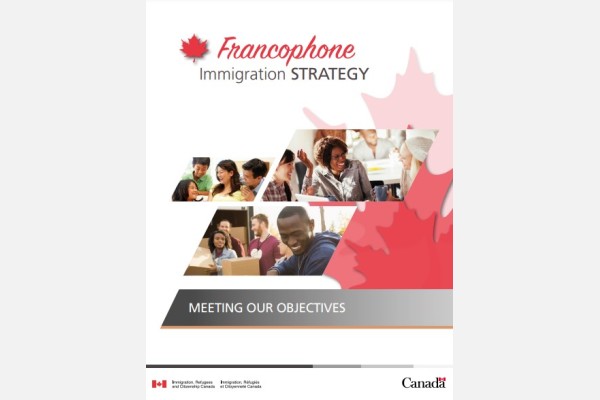Repository of Practices

Francophone Immigration Strategy (Canada)
Dates
Type of practice
Summary
Every year, thousands of French-speaking immigrants come to Canada to settle in Francophone communities outside of Quebec. In 2019, Immigration, Refugees and Citizenship Canada (IRCC) put in place the Francophone Immigration Strategy, which aims to support the vitality of Francophone minority communities across the country. The Francophone Immigration Strategy aims to achieve 3 main objectives:
1. Increase Francophone immigration to reach a target of 4.4% of French-speaking immigrants outside Quebec by 2023.
2. Support the successful integration and retention of French-speaking newcomers.
3. Strengthen the capacity of Francophone communities outside of Quebec.
To achieve these objectives, Canada’s Department of Immigration, Citizenship and Refugees (IRCC) has taken the following actions:
1. IRCC focused on adjusting immigration selection mechanisms for French-speaking candidates, including: (1) Additional points in the Express Entry system to assign additional points to candidates for strong French-language skills, with even more points for candidates who also have good English-language skills. (2) Better access to French tests. (3) In 2021, IRCC introduced temporary dedicated streams for French-speaking and bilingual candidates as part of the temporary residence to permanent residence pathway for essential workers and recent international graduates already in Canada.
2. Targeted expansion of promotion and recruitment support - Since 2003, IRCC’s office at the Embassy of Canada in France has organized an annual Destination Canada mobility forum, where participants from various countries can learn about the diversity of Canada, Francophone communities and Canadian immigration programs.
3. Joint action with key partners - IRCC recognizes the vital role played by many partners and stakeholders in the success of Francophone immigration. As part of mobilizing partners, in 2018, federal, provincial and territorial ministers responsible for immigration and those responsible for Canadian Francophonie adopted a Federal/Provincial/Territorial Action Plan for Increasing Francophone Immigration Outside of Quebec.
4. Enhanced resettlement and settlement pathways - In 2021-2022, IRCC provided $61 million in funding to more than 80 Francophone organizations to deliver a range of direct and indirect settlement services. The Francophone integration pathway is a consolidation of services, spanning from pre-arrival to citizenship, to facilitate linkages between French-speaking and bilingual newcomers and Francophone communities.
5. Coherent policies supported by data and outcomes - In January 2017, IRCC amended its immigration application forms to collect data under a new measure of the definition of “French-speaking immigrant”.
Organizations
Main Implementing Organization(s)
Detailed Information
Partner/Donor Organizations
Benefit and Impact
- The Francophone Immigration Strategy is a key pillar of the Government’s economic migration plan and will benefit both newcomers and host communities through economic and social integration activities in specific French-speaking communities.
- As vulnerable communities, Francophones greatly benefit from immigration on many levels, demographically, economically, culturally and socially.
- Having a continuous influx of new French-speaking members ensure that services and community institutions are maintained.
- In 2022-2023, IRCC will conduct an evaluation of the Francophone Immigration Strategy that will include assessing departmental results in meeting Canada’s 4.4% target by 2023.
Key Lessons
- The responsiveness to communities has taken the form of the principle of “for and by Francophone” in the implementation of certain activities, such as the Welcoming Francophone communities and the strengthened role of Réseaux en immigration francophone within the settlement sector at large.
- Enhanced Francophone integration pathway offering tailored support to French-speaking newcomers from pre-arrival to citizenship needs to be supported by a strong policy and program infrastructure.
Recommendations(if the practice is to be replicated)
- Streamlining and consolidating the approach (i.e. the Francophone Immigration Strategy) involves increased human resource and financial capacity to help develop necessary policies, tools, and practices.
Innovation
- Learning from this experience, IRCC is looking into the possibility of extending to more projects.
- In the context of the pandemic crisis, shift to virtual initiatives helped exploring new and innovative ways of delivering program activities, such as reaching a broader pool of French-speaking / bilingual talent for attraction and selection purpose, connecting with a more diverse spectrum of stakeholders and helped increased options for providing settlement services.
Additional Resources
Media
Language training in support of the Francophone integration pathway
Date submitted:
Disclaimer: The content of this practice reflects the views of the implementers and does not necessarily reflect the views of the United Nations, the United Nations Network on Migration, and its members.
More Related Practices:
- Domestic Workers League of ACV-CSC Brussels
- Environmental Migration Portal: Knowledge Platform on People on the Move in a Changing Climate
- Moving Towards Resilience: Documenting perceptions of in-place adaptation and migration in climate vulnerable communities
- Engaging Migrants and Diaspora Communities for an Inclusive and Climate-Resilient Blue Economy in Kenya
- Sesiones de formación de periodistas en migración, medio ambiente y cambio climático
Peer Reviewer Feedback:
*References to Kosovo shall be understood to be in the context of United Nations Security Council resolution 1244 (1999).
Newsletter
Subscribe to our newsletter.